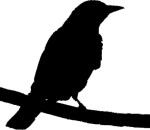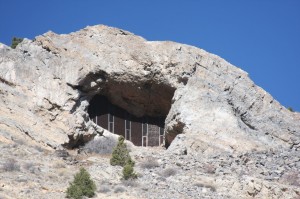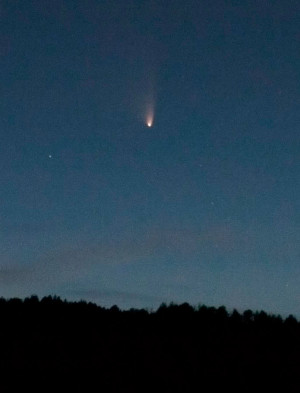By Tina Mitchell
The alarm buzzer slices through the darkness – 5:15 on a mid-December morning. Take a quick shower, pull on layer after layer of warm clothes, gulp down some breakfast and head out by 6:30. At U.S. Hwy. 50, we point ourselves west to Salida. Along the 18-mile drive, the Arkansas River and Bighorn Sheep Canyon slowly emerge in the pre-dawn light. Off to the annual Salida Christmas Bird Count!
 In the late 19th century, the Christmas “Side Hunt” served as a festive holiday tradition. People chose teams and ventured out to shoot as many creatures as they could. The team with the largest pile of fur and feathers at the end of the day claimed victory. Frank Chapman, from the newly formed Audubon Society, wanted to provide an alternative activity to highlight threats to bird populations and the importance of conservation. So on Christmas Day 1900, 27 pioneering volunteers at 25 sites across North America ventured forth to count all of the birds they could find – alive. (Pueblo served as one of these 25 sites, where Herman Nash tallied 14 species.) The Audubon Christmas Bird Count (CBC) had arrived.
In the late 19th century, the Christmas “Side Hunt” served as a festive holiday tradition. People chose teams and ventured out to shoot as many creatures as they could. The team with the largest pile of fur and feathers at the end of the day claimed victory. Frank Chapman, from the newly formed Audubon Society, wanted to provide an alternative activity to highlight threats to bird populations and the importance of conservation. So on Christmas Day 1900, 27 pioneering volunteers at 25 sites across North America ventured forth to count all of the birds they could find – alive. (Pueblo served as one of these 25 sites, where Herman Nash tallied 14 species.) The Audubon Christmas Bird Count (CBC) had arrived.
Between mid-December and the first week of January, the CBC now sends out tens of thousands of volunteers across the Western Hemisphere to take a census of each bird they see or hear within a 15-mile-diameter “count circle” during a 24-hour period. People travel in all sorts of weather on foot, by car, on skis, by snowshoe, in a kayak, by bicycle – and sometimes, various combinations of these.
The Salida CBC, begun in 2003, is a mountain CBC but encompasses an amazing variety of habitats for a mountain count. Geothermally heated seeps and farm ponds provide open water in even the coldest winters. One year, we spotted a Rusty Blackbird at a warm seep, far from her typical wintering grounds; Green-winged Teal frequent the farm ponds. The Arkansas River hosts an unusual array of waterfowl species, such as Barrow’s Goldeneyes, in addition to scores (sometimes hundreds) of the ubiquitous Mallards and Canada Geese. Even more intriguing is Sand (a.k.a. Sands) Lake – a pond warmed by the water from the fish hatchery upriver. Sand Lake stays toasty all winter, inviting unusual species to its spa-like atmosphere. Great-tailed Grackles, both Greater and Lesser Scaup – all are rare for the mountains, but not for Sand Lake. And of course, the count circle includes mountain areas (e.g. Maysville and the Rainbow Trail around Poncha Pass), offering high-altitude species such as Rosy-finches and Gray Jays. This outstanding diversity of habitats – all within a 15-mile-diameter circle – makes the Salida CBC routinely one of the most productive mountain CBCs in the state.
The Salida CBC pulls together 10 or 15 hardy folks, mostly from the Salida and Buena Vista areas. We gather at 7 a.m. to figure out teams and areas, hear about unusual species to watch for and catch up on how everyone’s been doing since the year before. We then spend the morning covering our assigned areas, tallying every bird we see or hear. We reconvene for lunch – paid for by our generous partners at Colorado Parks and Wildlife and the Greater Arkansas River Nature Association Bird Club – and a roll call to see what expected species we’ve missed and, sometimes, to amaze the group with unusual finds.
After lunch, we head out again to try to fill in gaps. Not a single Red-winged Blackbird so far? Back we go to the wetlands at Mt. Ouray State Wildlife Area (SWA). Not even one House Sparrow? Canvas any bird feeders in town. Someone spotted a white goose on the golf course – Ross’s Goose or Snow Goose? Cameras at the ready, we head there. No Bald Eagle on the list yet? Back to Big Bend and other stretches of the Arkansas River.
Surprises across the years have included three Trumpeter Swans on a farm pond, a lone Sandhill Crane grazing among cattle, more than 3,000 Bohemian Waxwings around town (the highest count of all the Colorado CBCs that year!), Virginia Rails and Swamp Sparrows at the wetlands of Mt. Ouray SWA, and four Eastern Bluebirds near Sand Lake – all species you wouldn’t expect to find about 15 miles from the Rocky Mountains near the winter solstice.
As the winter daylight begins to fade, we turn in our checklists and eagerly await the email from the compiler with the group’s final numbers. Over its 10-year history, the group has averaged 73 species and more than 3,500 individual birds each year (excluding the count of the highly unusual invasion of Bohemian Waxwings).
In our family, the Salida CBC has become a holiday tradition, filled with camaraderie, adventure, surprises and fascinating encounters with winter’s nature. For us, Christmas is for the birds!
This year the Salida CBC will be Saturday, Dec. 21. If you’d like more information, contact Andrew Mackie at andrewjmackie@gmail.com or 719-239-0281.
Tina Mitchell watches nature with her human and canine family from their perch in the piñon/juniper habitat of western Fremont County. When she needs to pay the bills, she shows up as a research psychologist on the University of Colorado Anschutz Medical Campus in Aurora.





